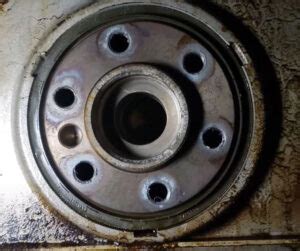Solving Your Rear Main Seal Leak Problem: An Easy Guide
A rear main seal leak is a frustrating and messy problem for any car owner. That telltale drip of oil on your garage floor is not only unsightly but also a potential indicator of a more serious engine problem if left unaddressed. This comprehensive guide will walk you through understanding the cause, diagnosing the issue, and exploring solutions for your rear main seal leak. We'll cover everything from simple fixes to more involved repair strategies, helping you get back on the road with a dry, leak-free engine.
What is a Rear Main Seal?
Before diving into solutions, let's understand the culprit. The rear main seal is a crucial component located where the engine block meets the transmission. Its job is to prevent engine oil from leaking out at this critical juncture. Over time, this seal can wear down, harden, or become damaged, leading to the dreaded oil leak.
Identifying a Rear Main Seal Leak: Signs and Symptoms
Pinpointing the source of an oil leak can be tricky, but here are some key indicators that suggest a rear main seal problem:
- Oil drip on the ground: This is the most obvious sign. Look for a drip directly beneath the engine, closer to the transmission.
- Oil staining: Check for oil staining on the transmission bell housing or the engine block near the transmission.
- Low oil level: Regularly check your dipstick. Consistent low oil levels despite no other apparent leaks point towards a rear main seal leak.
- Oil smell: A persistent oil smell emanating from the rear of your engine could indicate a leak.
How to Diagnose a Rear Main Seal Leak?
While the symptoms above strongly suggest a rear main seal leak, it's crucial to confirm the diagnosis before embarking on repairs. Here’s how:
- Visual Inspection: Carefully examine the rear of your engine, looking for oil residue. A flashlight and a clean rag can help you see better.
- Cleaning Test: Thoroughly clean the area around the suspected leak. Drive the car for a short distance and then re-inspect. A fresh oil stain will pinpoint the leak's origin. Be cautious – never work under a hot engine.
- Mechanic's Input: If you're unsure, consulting a mechanic for a professional diagnosis is always a good idea. They have the expertise and tools to accurately assess the situation.
What Causes a Rear Main Seal to Leak?
Several factors can contribute to rear main seal failure:
- Age and Wear: Over time, seals naturally deteriorate due to heat, vibration, and exposure to oil.
- Improper Installation: Incorrect installation during engine repair or maintenance can damage the seal.
- Oil Contamination: Contaminants in the engine oil can accelerate seal degradation.
- Transmission Issues: Problems within the transmission can sometimes put extra stress on the seal.
- High Mileage: Cars with high mileage are more prone to seal leaks due to accumulated wear.
Solutions for a Rear Main Seal Leak: From Simple Fixes to Major Repairs
The best solution depends on the severity of the leak and your mechanical abilities.
1. Addressing Minor Leaks (Temporary Solutions):
For minor leaks, these temporary fixes may help buy you some time:
- Sealant Additives: Some engine oil additives claim to help repair minor seal leaks. The effectiveness varies, and it's not a long-term solution.
- Increased Oil Changes: More frequent oil changes can help slow down seal deterioration and reduce the severity of the leak.
2. Rear Main Seal Replacement: The Definitive Solution
This is the most common and effective solution for a persistent rear main seal leak. It involves removing the transmission, replacing the damaged seal, and reassembling everything. This repair is best left to experienced mechanics due to the complexity of the process.
3. "Stop Leak" Products: A Cautionary Note
While readily available, "stop leak" products should be used with caution. They can sometimes worsen the problem by clogging oil passages or damaging other engine components. They are usually seen as a temporary fix at best.
How Much Does Rear Main Seal Repair Cost?
The cost of rear main seal replacement varies greatly depending on factors like the vehicle's make and model, labor rates in your area, and the mechanic's experience. Expect to pay anywhere from a few hundred dollars to potentially over a thousand for a complete repair.
Frequently Asked Questions
How long does it take to replace a rear main seal?
The time required for a rear main seal replacement can vary significantly, but it often takes a qualified mechanic several hours, sometimes even a full day, depending on vehicle complexity.
Can I drive with a rear main seal leak?
While you can technically drive with a small rear main seal leak, it’s not advisable. Driving with a significant leak risks engine damage due to low oil levels. It also poses environmental and safety hazards due to oil spills on the road.
How often should I check for rear main seal leaks?
Regularly checking your oil level and visually inspecting the area around the rear of your engine during routine maintenance is recommended. Pay close attention to any oil stains or drips.
Is a rear main seal leak always a serious problem?
A small, slow leak might not be immediately catastrophic, but ignoring it can lead to significant engine damage due to oil starvation. It's crucial to address any rear main seal leak promptly.
This guide provides a comprehensive overview of diagnosing and resolving rear main seal leaks. Remember, safety is paramount, and when in doubt, consult a qualified mechanic. They possess the necessary expertise and tools to accurately diagnose and repair your vehicle.

